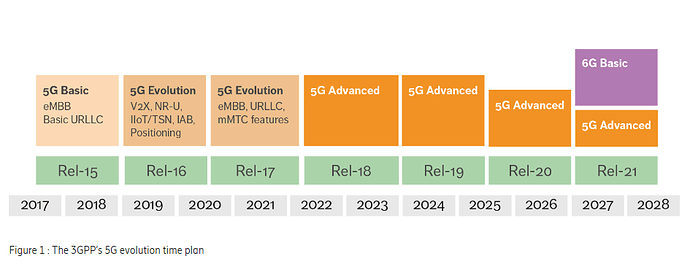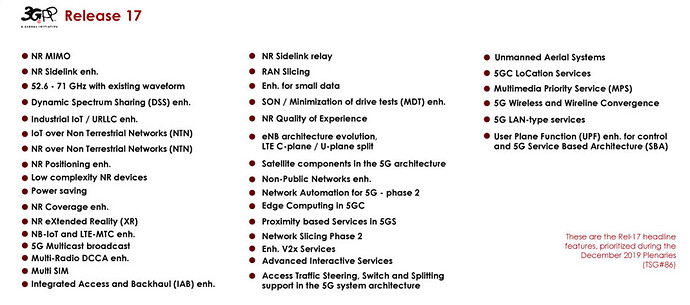Key Highlights
![]() The path toward 5G Advanced begins with Rel-17, which includes significant enhancements to several radio access network (RAN) functionalities that are already deployed in live New Radio (NR) networks.
The path toward 5G Advanced begins with Rel-17, which includes significant enhancements to several radio access network (RAN) functionalities that are already deployed in live New Radio (NR) networks.
![]() Rel-17 MIMO enhancements address four areas:
Rel-17 MIMO enhancements address four areas:
- beam management
- multiple transmission & reception point (mTRP) for URLLC
- mTRP for eMBB
- TDD & FDD reciprocity.
![]() Dynamic Spectrum Sharing - From Rel-17 onwards, cross-carrier scheduling allows for the data channels to be scheduled on the shared primary cell using the PDCCH of a downlink secondary cell.
Dynamic Spectrum Sharing - From Rel-17 onwards, cross-carrier scheduling allows for the data channels to be scheduled on the shared primary cell using the PDCCH of a downlink secondary cell.
![]() UE Power Savings -Rel-17 includes power-saving enhancements for UEs in Radio Resource Control (RRC) connected, idle and inactive modes. Power-efficiency improvements are specified both for eMBB UEs and reduced-capability (RedCap) devices.
UE Power Savings -Rel-17 includes power-saving enhancements for UEs in Radio Resource Control (RRC) connected, idle and inactive modes. Power-efficiency improvements are specified both for eMBB UEs and reduced-capability (RedCap) devices.
![]() Positioning -In Rel-17, NR positioning is further improved for specific use cases such as factory automation by targeting 20-30cm location accuracy for certain deployments. Rel-17 also introduces further enhancements to latency reduction to enable positioning in time-critical use cases such as remote control applications.
Positioning -In Rel-17, NR positioning is further improved for specific use cases such as factory automation by targeting 20-30cm location accuracy for certain deployments. Rel-17 also introduces further enhancements to latency reduction to enable positioning in time-critical use cases such as remote control applications.
![]() 3GPP release 18 – introducing 5G Advanced The 3GPP RAN standardization team began discussing the scope of Rel-18 in June 2021 at the 3GPP RAN Rel-18 Workshop and aims for approval of the detailed scope by December 2021.
3GPP release 18 – introducing 5G Advanced The 3GPP RAN standardization team began discussing the scope of Rel-18 in June 2021 at the 3GPP RAN Rel-18 Workshop and aims for approval of the detailed scope by December 2021.
![]() Of the more than 500 proposals that were submitted to the workshop, Ericsson has identified to be the most important highlights and placed them in three categories.
Of the more than 500 proposals that were submitted to the workshop, Ericsson has identified to be the most important highlights and placed them in three categories.
![]() Key enhancements for e-MBB use cases
Key enhancements for e-MBB use cases
-
Three of the most notable Rel-18 additions for eMBB use cases are beamforming/MIMO, mobility enhancements and network power savings.
-
Advanced antenna systems (AASs) are the main driver for increasing spectral efficiency of wireless networks, and they will continue to evolve due to factors such as enabling layer 1/layer 2 mobility, further improvements of uplink MIMO and enhancements related to fixed-wireless access applications.
-
DSS is extremely useful when transiting from 4G to 5G and many commercial networks already rely on it. To increase network efficiency during that transition, further enhancements are envisioned, such as improved NR performance when the number of LTE UEs decreases gradually, and reduced impact on NR performance due to interference from LTE broadcast signals.
-
Rel-18 also includes efforts to explore opportunities to further reduce network energy consumption.
![]() Key enhancements for non-eMBB use cases
Key enhancements for non-eMBB use cases
-
The most notable enhancements for non-eMBB applications (such as new or existing verticals) include RedCap, XR and national security and public safety (NSPS). RedCap UEs are expected to play a significant role in many future applications.
-
Based on Rel-17, Rel-18 RedCap solutions will further reduce device cost & power consumption. Solutions enabling energy harvesting, such as energy-efficient wake-up radios, will be investigated.

